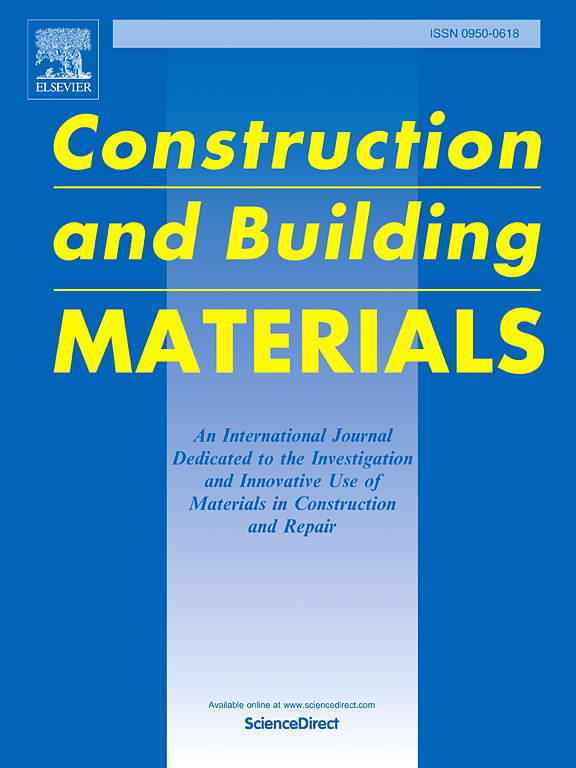Nano-adhesion behavior and failure mechanisms of polymer cement-based materials at high temperature
IF 7.4
1区 工程技术
Q1 CONSTRUCTION & BUILDING TECHNOLOGY
引用次数: 0
Abstract
Molecular dynamics simulations were performed to investigate the interfacial adhesion behavior between polymers and cement-based material substrates. Three kinds of polymers were constructed and validated based on literature reviews, ethylene-vinyl acetate (EVA), styrene-acrylate (SAE), and styrene-butadiene (SB) copolymers, respectively. The molecular modeling of the cement-based materials was constructed by means of its two main components, calcium silicate hydrate (C-S-H) and silicon dioxide (SiO2). C-S-H-polymer-C-S-H and C-S-H-polymer-SiO2 composite structures under uniaxial tension were simulated at ambient temperature of 300 K, 350 K, and 400 K, respectively. The results reveal that the polar functional groups in EVA and SAE polymers form coordination bonds and H-bonds with C-S-H/SiO2, thereby enhancing the adhesion of these two polymers to the substrate. As for the SB polymer without polar functional groups, the C(C![]() C) atoms form weak electrostatic interactions with the Ca atoms on the surface of C-S-H. In addition, with increasing temperature, (i) the number and the stability of the coordination and H-bonds formed between EVA and C-S-H/SiO2 decreased, leading to a decrease in adhesion, (ii) the electrostatic interaction between SB and C-S-H weakened, which also led to a decrease in adhesion, and (iii) the COO- group was gradually formed through hydrolysis of SAE, thereby improving the adhesion performance.
C) atoms form weak electrostatic interactions with the Ca atoms on the surface of C-S-H. In addition, with increasing temperature, (i) the number and the stability of the coordination and H-bonds formed between EVA and C-S-H/SiO2 decreased, leading to a decrease in adhesion, (ii) the electrostatic interaction between SB and C-S-H weakened, which also led to a decrease in adhesion, and (iii) the COO- group was gradually formed through hydrolysis of SAE, thereby improving the adhesion performance.
高温下聚合物水泥基材料的纳米粘附行为及破坏机制
通过分子动力学模拟研究了聚合物与水泥基材料基质之间的界面粘附行为。在文献综述的基础上,构建并验证了三种聚合物,分别是乙烯-乙酸乙烯酯(EVA)、苯乙烯-丙烯酸酯(SAE)和苯乙烯-丁二烯(SB)共聚物。通过水合硅酸钙(C-S-H)和二氧化硅(SiO2)这两种主要成分构建了水泥基材料的分子模型。分别在300 K、350 K和400 K环境温度下,模拟单轴拉伸下C-S-H-polymer-C-S-H和C-S-H-polymer-SiO2复合结构。结果表明,EVA和SAE聚合物中的极性官能团与C-S-H/SiO2形成配位键和氢键,从而增强了这两种聚合物与基体的附着力。对于不含极性官能团的SB聚合物,C(CC)原子与C- s - h表面的Ca原子形成弱静电相互作用。此外,随着温度的升高,(1)EVA与C-S-H/SiO2之间形成的配位键和氢键的数量和稳定性减少,导致附着力下降;(2)SB与C-S-H之间的静电相互作用减弱,也导致附着力下降;(3)通过SAE的水解逐渐形成COO-基团,从而提高了附着力。
本文章由计算机程序翻译,如有差异,请以英文原文为准。
求助全文
约1分钟内获得全文
求助全文
来源期刊

Construction and Building Materials
工程技术-材料科学:综合
CiteScore
13.80
自引率
21.60%
发文量
3632
审稿时长
82 days
期刊介绍:
Construction and Building Materials offers an international platform for sharing innovative and original research and development in the realm of construction and building materials, along with their practical applications in new projects and repair practices. The journal publishes a diverse array of pioneering research and application papers, detailing laboratory investigations and, to a limited extent, numerical analyses or reports on full-scale projects. Multi-part papers are discouraged.
Additionally, Construction and Building Materials features comprehensive case studies and insightful review articles that contribute to new insights in the field. Our focus is on papers related to construction materials, excluding those on structural engineering, geotechnics, and unbound highway layers. Covered materials and technologies encompass cement, concrete reinforcement, bricks and mortars, additives, corrosion technology, ceramics, timber, steel, polymers, glass fibers, recycled materials, bamboo, rammed earth, non-conventional building materials, bituminous materials, and applications in railway materials.
 求助内容:
求助内容: 应助结果提醒方式:
应助结果提醒方式:


